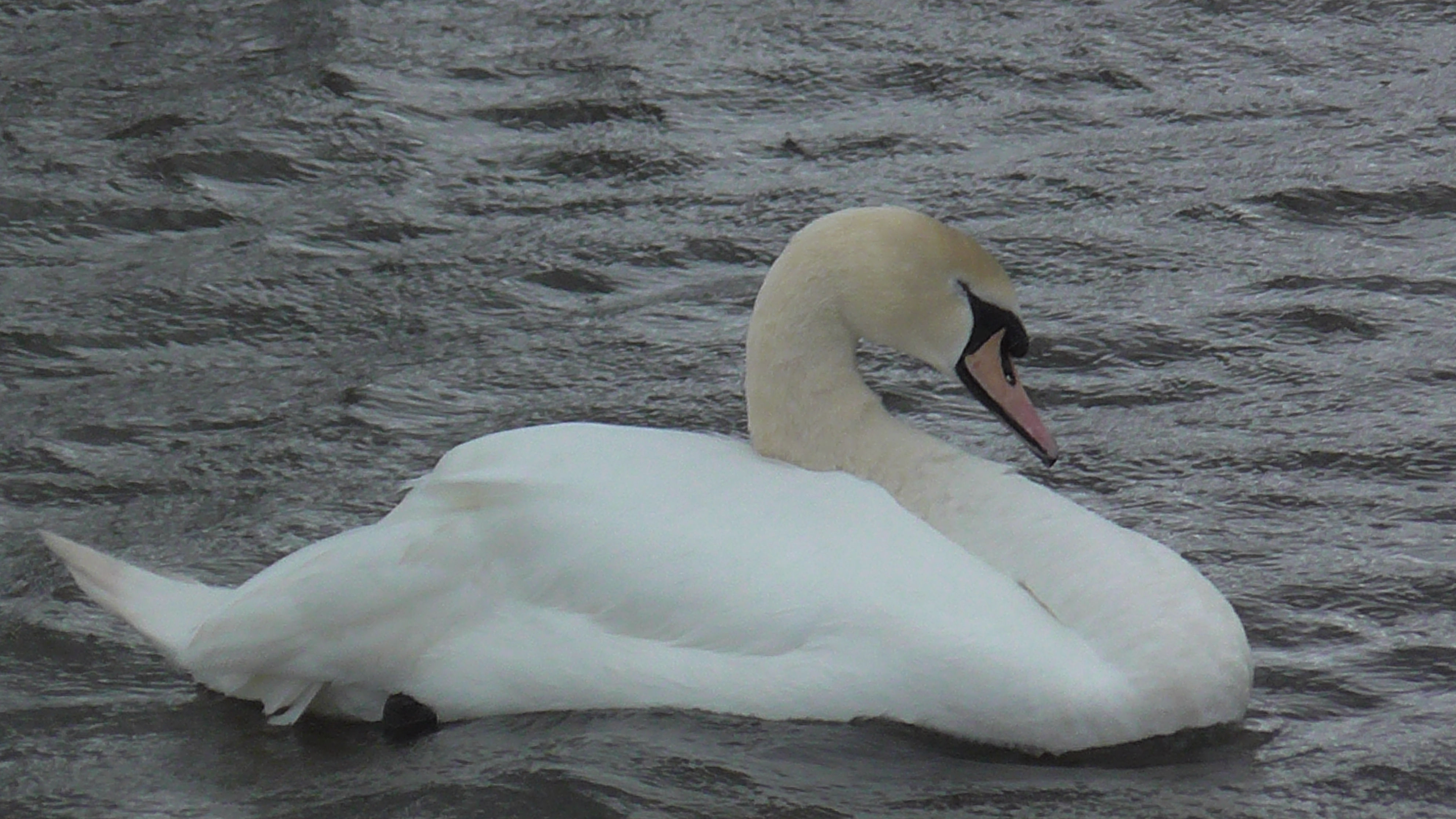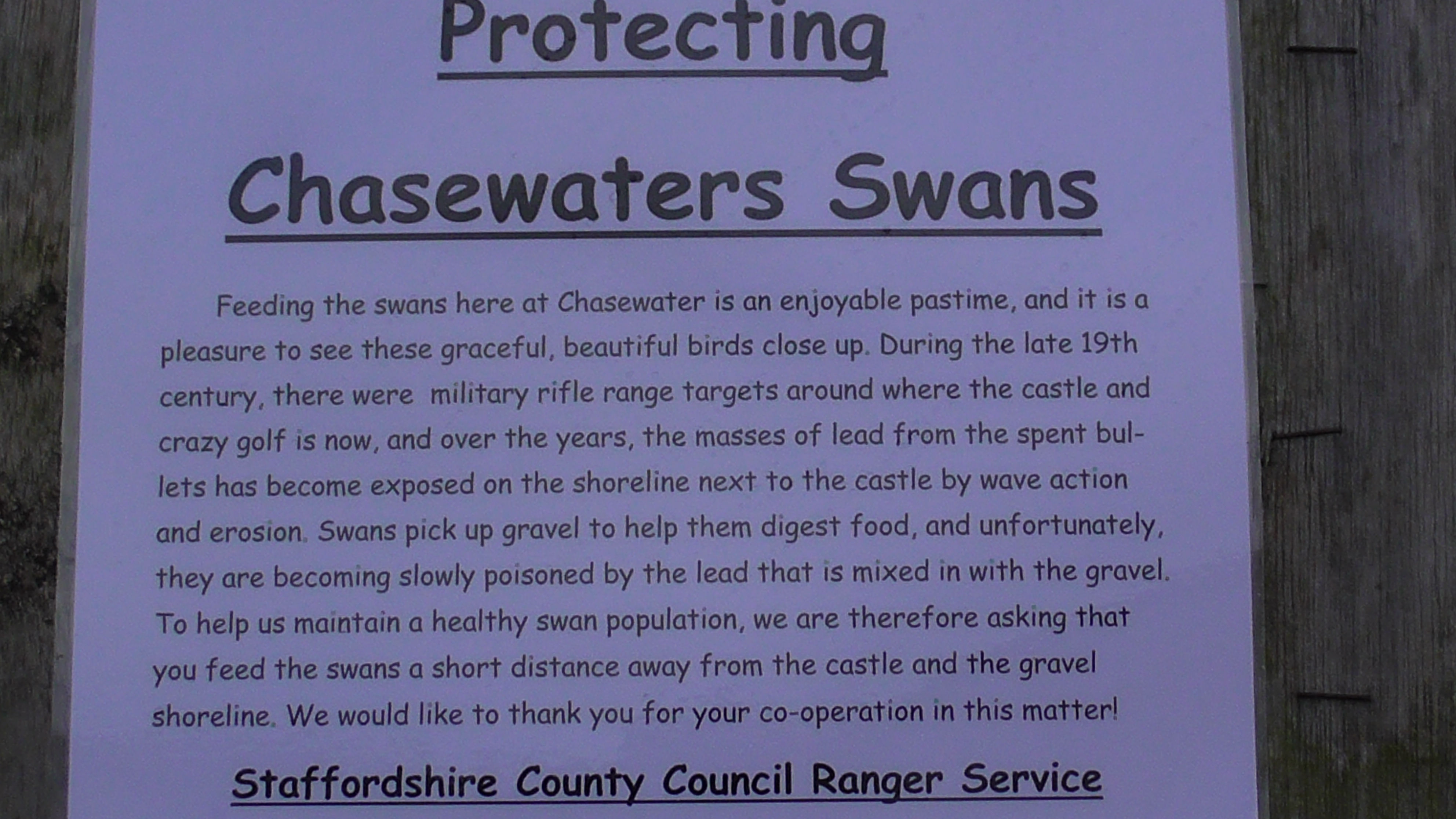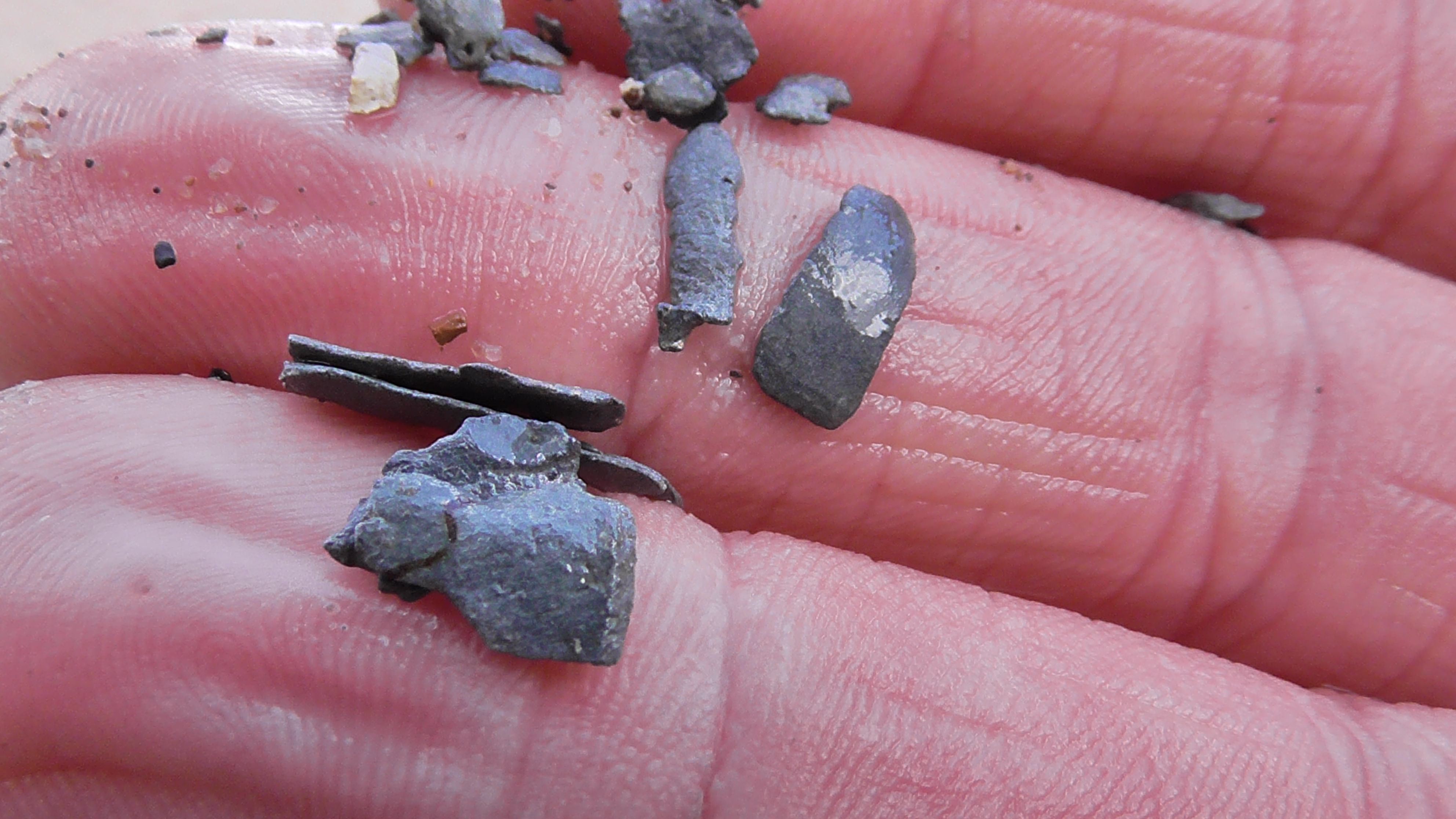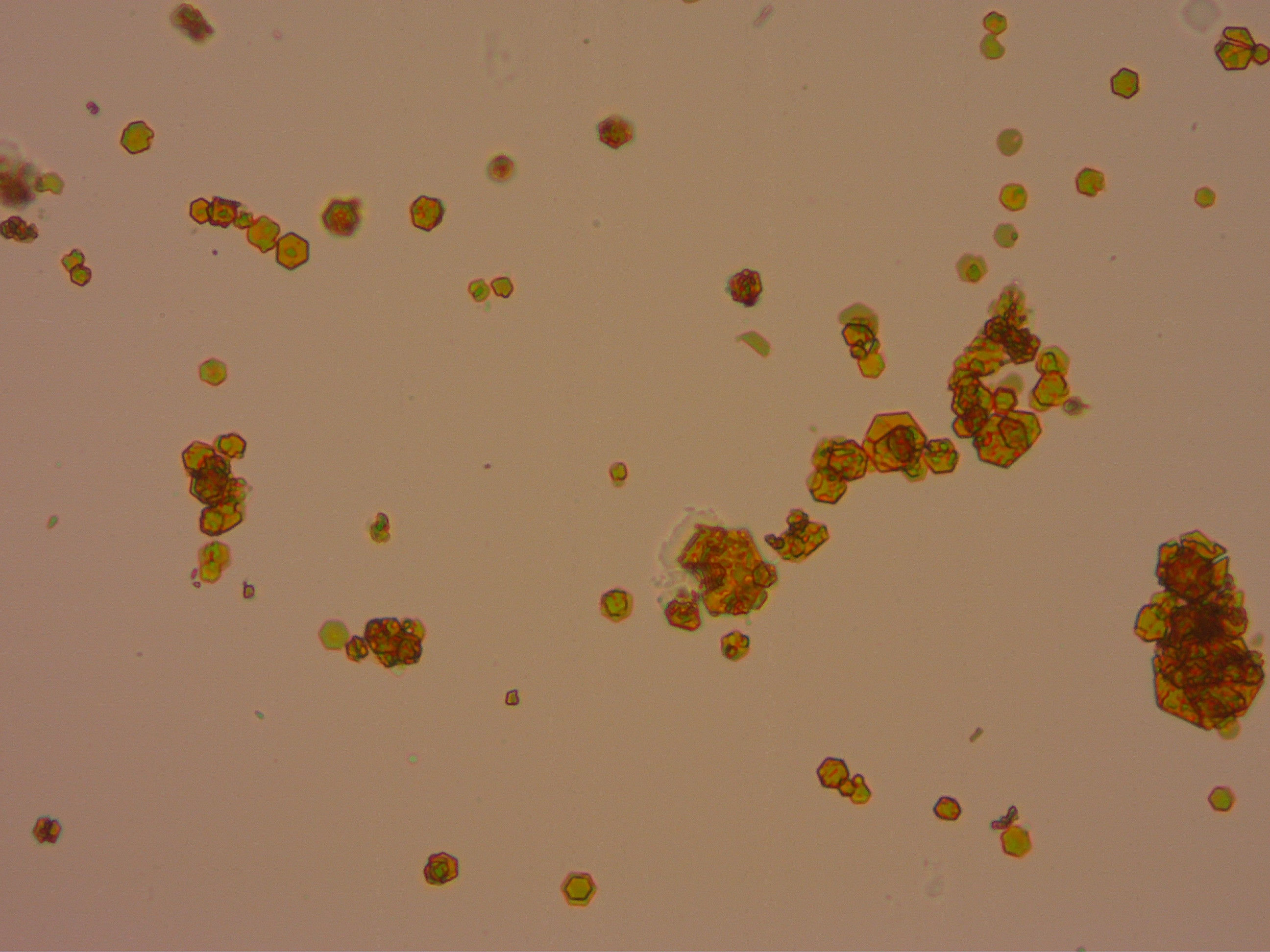This is a long post which covers a number of subject areas relevant to this website. Fundamentally it relates to investigating unexplained wildfowl illnesses and deaths which appear correlatively linked to certain sites, so much so that it is almost certain that the problem lies with something at that site.
This was certainly the case at Rattlechain, though the chemical in question there, white phosphorus, was extremely difficult to pin down, not least because the site operators were not honest about their waste practices and the waste regulators had not a bloody clue about much at all. It was also the case that the chemical could not be analysed by a standard laboratory due to its evanescent nature after birds had been retrieved for post mortem.
It was also necessary to firstly identify that this chemical was even present in the birds, which in the early days was not possible because we did not know enough. This changed with serendipity and contacting relevant experts in the field, which together with on site knowledge led to the site operators having to finally end the nonsense that they had been spinning for several years- that the site was a “haven for wildlife”, when all along they were fully aware that it contained tens of tonnes of a banned rat poison they and their predecessors had dumped there.
White phosphorus is an unusual and uncommon chemical for wildfowl to encounter, especially given that Rattlechain is probably unique in the UK, and probably similarly in Western Europe. But there are other major poisoners of wildfowl which are far more common and have been studied extensively by scientists for many years. The main one involving swans is lead.
The source from which the birds are ingesting the material is highly controversial, but it is clear that a ban on certain mid range lead fishing weights reduced the number of fatalities. It does however remain a major cause of swan mortality and reason for wildfowl admission to rescue centres.
First of all a quick summary. In the mid 1970’s there was a major decline in the mute swan population in the UK. Major investigations revealed lead poisoning was to blame, and in particular the use of angler’s lead weights which could be easily ingested as birds foraged for food. A partial ban of these in 1987 removed the mid range of lead weights, though the upper and smaller dust shot sizes remained. Lead used in shooting remains in use.
The National Swan Convention, an umbrella group of swan rescue organisations in conjunction with the Environment Agency set up a project to assess the impact of discarded and lost fishing tackle and lead in particular, on swans. In January 2002 this project produced its final Research & Development Report which confirmed that lead poisoning has re-emerged as a very significant problem. According to the NSC website, some groups have reported more than 35% of birds with blood lead levels greater than would render individuals poorly, and in the West Midlands it is well over 60%.
“The National Convention for the Welfare of Swan & Wildlife (now known as The National Swan Convention) is committed to establish the precise reason for this – what is the source of this lead? The obvious possibilities are:
- Angler’s lead shot deposited before the current ban in 1987
- Angler’s lead shot rendered illegal by the 1987 legislation
- Angler’s lead dust shot used legally
- Lead shot-gun shot”
Further information on how lead affects swans and other wildfowl can be read below, which was written by former MAFF veterinary pathologist Alan Hunt and his wife, who worked on lead poisoning extensively.
Some areas are noted for high levels of birds affected. The West Midlands in general is such a “blackspot” area, and within these areas there are certain sites that are of note. One of them is Chasewater Country Park, located near Brownhills, Walsall. It is a major area of water and attracts a vast variety of wildlife and wildfowl including moulting swans. Formerly it appears to have had multiple transfer of ownership from Brownhills Urban council, Walsall council, Lichfield District Council and now Staffordshire County Council. This is important please note.
Having visited the site for a number of years both myself and other volunteers have from time to time noted noticeably ill birds, which when taken into care have been confirmed to be suffering from lead poisoning based on high blood lead levels readings taken. This evidence is clear, independent and irrefutable. Some birds respond to treatment but many do not and it can depend on speed of early clinical signs being recognised, which unfortunately many people are not aware of. The source however is not so easy to pin down- but it has to be a source from this site surely?
In the last few years the site has undergone major changes. Lichfield District council transferred the site to Staffordshire County Council in 2011. Serious flaws were found in the adjoining dam wall which needed to be repaired and the main lake was almost fully drained. At this point many of the wildfowl, particularly the swans transferred themselves to a smaller pool known as “the duck pool”. This was almost a shallow paddling pool with an island, and Lichfield District Council appeared to take interest in this during their tenure by installing ramps and nesting materials every year. It was also used for sailing model boats. Several domestic birds congregated with the other birds. It was a popular feeding spot for families.
For the period that the lake was drained and the swans took to the duck pond, there were few issues concerning lead poisoning. One could draw a conclusion therefore that they were not ingesting a source of lead from this shallow none fishing pool, and therefore that the issue was with the main lake.
Then enter Staffordshire County Council. Not long after they took over from Lichfield and the main lake had started to refill again, the duck pond was inexplicably drained. Notices went up stating that the water was contaminated and needed to be drained, CRUCIALLY IT WAS STATED THAT THE POOL WOULD BE REFILLED. NOTICES WERE PUT UP BY THE COUNCIL ON THE FENCED OFF AND DRAINED POOL.
This was posted on the Chasewater country park Facebook page, and was identical to those stuck on the fencing. This quite clearly identifies this pond as “the duck pond”, and also states that the water is being removed to improve conditions for the birds. It is apparent here that the water would soon be refilled.
The evicted wildfowl then headed back to the main lake. At the start of the year, and continuing now, several swans were noted to becoming ill again, with what I identified as clear lead poisoning symptoms. I am aware of at least 6 swans to date that have either been found dead or have died when picked up. Some of them have been confirmed to be suffering from lead poisoning, with the AHVLA also undertaking post mortems on some birds. The RSPCA have taken some birds to their Stapeley Grainge wildlife hospital in Cheshire.
So I raised the issue with the council. I asked questions about the duck pond and when it was going to be refilled, now many months after it had been drained given that the claim made in notices that the council had put up stated clearly that it would be soon refilled. The notices then disappeared, and in their place others appeared making claims about the history of the main lake.
Another notice appeared in “the rangers rant” flyer at the site- shown below- where again claims about a 19th Century rifle range are made. 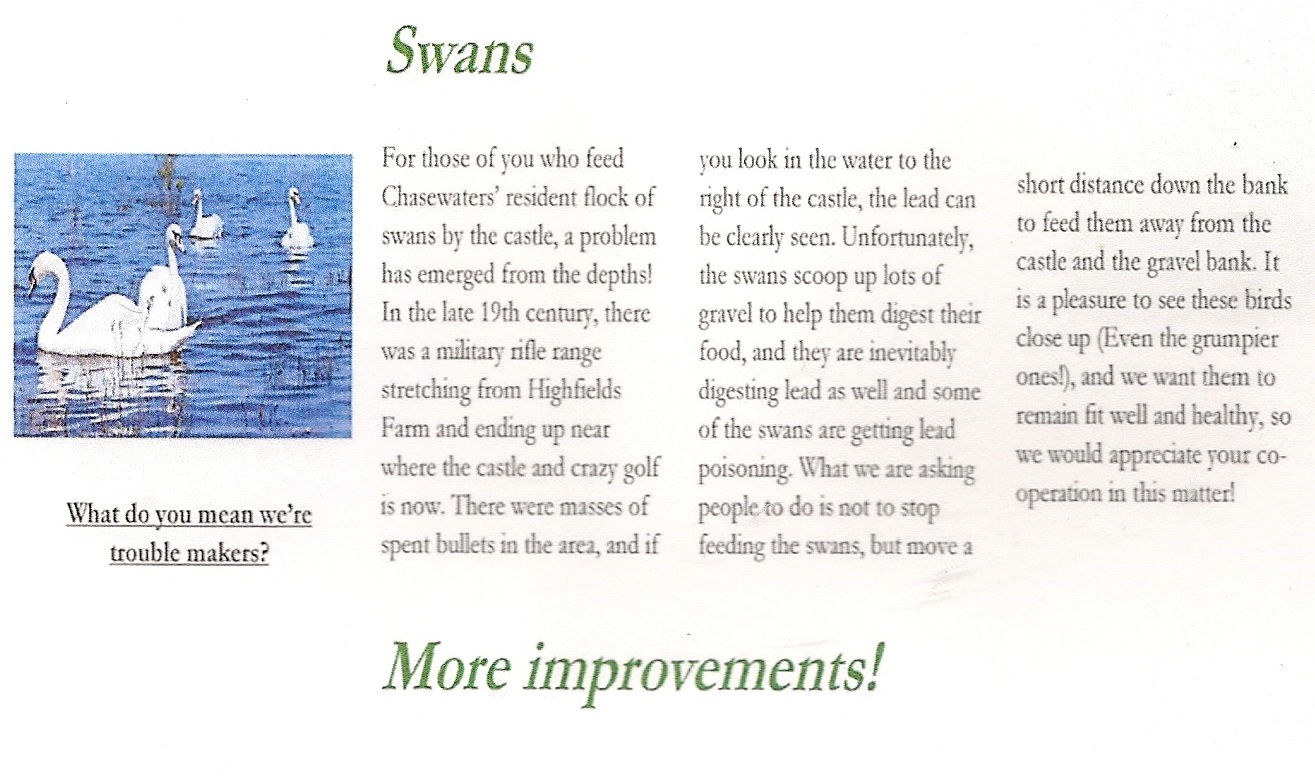 But is there any real evidence that this is the long lost source of lead? There does appear to be some historic rifle range in the area in question. This is shown in an nls Staffordshire map from 1883 below
But is there any real evidence that this is the long lost source of lead? There does appear to be some historic rifle range in the area in question. This is shown in an nls Staffordshire map from 1883 below
. nls (5)
The next available map from 1903 does not show a range marked.
But I find this quite baffling indeed and probably unlikely. This council have allowed this pool to be drained where the birds were away from the source of contamination that for some reason no one had ever appeared to identify when the site was owned by Lichfield District Council. Indeed I do not possibly see how Staffordshire can identify the source of lead poisoning where as described above, this requires almost impossible science. PERHAPS THEY ARE CLAIRVOYANTS.
If you sense a feeling of anger rising, then you are very perceptive, because I always found Lichfield council to be very caring about the wildfowl, and ranger Jan Lee in particular spent a great deal of her time caring for the injured birds at the site, and they had pens to keep the birds in until the RSPCA arrived.
- Staffordshire County Council have now got rid of them all.
- They do not rescue wildfowl at all.
- Their attitude is a fucking disgrace to be frank.
So confronted as usual with being the one that had to do something, I have took it upon myself to launch an investigation into all of this, the lead, the drained duck pond and the claims made by Staffordshire County Council regards the source of the lead poisoning in the swans. At the same time it should also be appreciated that although they have identified a problem, both they and Natural England appear to be doing nothing about stopping it by removing the source- on what one is frequently reminded a “SSSI site.”
Firstly what lies beneath? I scoured the area where they claimed the lead was located, and sure enough there were clear metallic particles visible near surface level, mixed in with shell and gravel and brick. Quite easy for birds like swans to ingest when seeking out gravel to aid their digestion of food in the gizzard.
But on scooping out some of this material, it is apparent that this does not look like spent bullets from the 19th Century rifle range. Indeed the clump formation appear much fresher than this period, and the fragments of metal vary in shape and size, and appear more like flat metal working spoil than ballistic fragments, and certainly not anglers split shot lead, old or new. BUT IS IT LEAD?
Well it is light and malleable but does not mark a page, as lead should. For confirmation I have asked for some advice on this, and so it was that I sent some off to a university laboratory. Although only basically equipped, the laboratory tests appear to confirm that it does contain lead, but not that it is pure lead. Quite honestly I suspect pewter.
Freedom of information requests.
I have made two Freedom of information requests concerning this. The first was to Staffordshire County Council themselves. Verbally they appeared to be blaming the duck pond issue on Lichfield District council, illegally releasing soiled water into the main lake. They also made claims concerning Natural England stating that they could not continue to do this because the site is supposedly classed as a SSSI- Site of Special Scientific Importance. More on this later…..
I asked “I am requesting any recorded information that you hold including emails with regards to communications with Natural England about the Chasewater Country Park’s duck pond, its emptying , the reasons behind this and the reasons why it has not been refilled after several months. Can I also request at what level was the decision within the county council taken not to refill the pond , and I would again request any recorded information that you hold which reveals this.” The response that I received did not provide anything but constructed spin and a potted history of events.
- “The “pool” is not a duck pond. It was originally created as a model boating lake which has been used recently by visitors to the Park for canoeing and kayaking. However, over recent years members of the public have fed the wildfowl both on and by the pool, encouraging them to settle on the boating lake. The water level, and to some extent its purity, is maintained via a valve which allows the water to be discharged as necessary into the Reservoir. However, when the county council took over the management of the Park from Lichfield District Council in 2014, the valve was not working and the boating lake was badly silted up, mainly because of the bird feeding. Since the boating lake was created, part of the Chasewater site and the Reservoir has been designated a Site of Special Scientific Interest (SSSI) because of certain nationally important features including the aquatic plants in the Reservoir. The Reservoir has to be managed sympathetically to maintain its low nutrient status which is vital for the flora to survive. Natural England was consulted, therefore, on the discharge of the boating lake because of this designation. The water in the boating lake was tested at this time and the phosphate level was high because of the bird feeding and therefore too high for it to be released into Chasewater. The county council subsequently had to spend in the region of £15,000 emptying the pool and removing the silt. Natural England also advised the phosphate level would continue to accumulate if the wildfowl were encouraged to settle on and around the boating lake and that the level would always be too high for the water to be discharged into the Reservoir.” In our view, emptying the boating lake manually is not an option because of the ongoing substantial cost, particularly when improvements still need to be carried out on the Park which would benefit all our visitors. We are currently considering options for the former boating lake which are likely to require planning permission. The public will have an opportunity to comment on the planning application in due course.”
A number of points emerge here.
- This is not the information requested, but the council’s viewpoint which cannot be corroborated. I asked for the correspondence claiming that Natural England had told them they could not release the water back unto the main lake. i.e letters or emails.
- “The duck pond” has been occupied by birds for at least two decades and Lichfield encouraged birds onto this lake, and were justified in doing so in my opinion- especially given the plunging levels in the main lake which could leave some nesting birds marooned on dry beaches.
- We hear the old chestnut concerning “phosphate”. For some reason Natural England appear to have a big problem with this, but could not give a fuck about birds being poisoned by lead at this “SSSI SITE”.
- One can only ponder the planning application- though I would not be surprised at all if we see another “poor man’s gym” erected- something which appears to be very popular these days with local authorities.
- They appear to blame duck feeders, another usual trick of the CONservationists who are of course not too concerned with destructive water sports on such a site because they give them money. I wonder what they blame the “wave action” causing erosion on- farting coots?
And money my friends is what this is really all about. Since Staffordshire took over their sole concern is making money out of Chasewater- particularly out of destructive water sports and the revenue it provides.They appear to want to create a mini Midlands Windermere, but that is an abhorrent vision for wildfowl lovers like myself. Birds cannot co-exist with water skiing and power boating- they just can’t – whatever the fuckwit apologists taking a crown out of PR promotion may claim.
Bottom line, the dam repairs left them financially in the do-do, and they needed a quick way of making back the doe. I have seen birds injured by these activities at this site and others. The fun seekers do not care about wildfowl- they are a “nuisance”- and we all know what happens next. That the issue of phosphate being raised means that the water sports users and their attractors at this council are eager not to allow such discharges into the main lake- even though it had apparently been going on for years under Lichfield District Council.
The SSSI reason is a crock of shit smokescreen and the promotion of water sports at this site doesn’t appear to have come into the equation at their precious site when planning applications have surfaced.
‘Installation and operation of a straight line cable tow wakeboarding facility and associated works’ and is being made by Wakelake Limited, of Burton on Trent.
Here’s the ecology report for this one.
“Proposed Works The proposal is to install and operate a wakeboarding area on two tow cables that will extend into the lake for approximately 170 metres (Figure 1.2). In addition to the two cable tow systems, the following will be included: 1. Two floating docks at the far end of the pier which will be used as starting points 2. Six obstacles (4 on cable A and 2 on cable b), 3. Some buoys in the water to delineate the wakeboarding area from other users on the water. ” Disruption to flight lines (birds) Operational Two cable lines at 8m height covering the SE bay and a length of open water adjacent to the dam All year if towing cables remain in situ over winter non operational months Small area of the lake affected, but may cause problems for geese and swans flying over the dam from the east. Moderate impact.”
This application was approved. So swans and other wildfowl now have the obstacle in their flight paths of two unmarked sets of wires as they fly over the Wyrley and Essington Canal- something that was never there before- but no problem it seems to the glorious “SSSI” site- how much are the operators paying the council?
The author of this report for “Staffordshire ecological services” is one Dave Haslam. Now perhaps this may be a case of mistaken identity. For I remember another Dave Haslam who used to be senior Countryside ranger at Walsall council. I went to see him one time concerning wanting to put in a nesting raft at a Walsall pool, and to make suggestions due to the swans having serious problems there. I’m a volunteer, not a money making business and I get nothing from trying to help the birds financially. Every suggestion was met with an unceremonious “NO NO, NO, NO, NO, NO, NOTHING MANMADE, NOTHING ARTIFICIAL.”
Notwithstanding the fact that the site in question was entirely manmade and acquired by the said council for a reported 1 quid, I resigned myself to the fact that he didn’t want anyone pissing on his conservation parade. But surely it would be seen to be hypocritical for someone who took money for “ecologically advising” people how they go about installing manmade structures on lakes such as Chasewater, if that same person had previously dismissed my humble suggestions with nothing but “NO”. Different bloke, must be, Because I can’t believe that such a two faced fucking hypocrite could exist. The Dave Haslam at Walsall no longer works there though, but I note that SES claim that both Walsall MBC and Lichfield DC are both former clients on their website.
That brings me neatly to my second FOI request– this time concerning Walsall council and their past activities- who appear to have used part of the site as a parks and countryside tip. Back in the day, it appears that the vision then was to create a seaside experience- call it “Burntwood Butlins”. They called it “Chasewater pleasure park”. A castle and pier were added in the early 60’s , and no doubt that’s when Mr whippy and friends moved in too.
A site licence appears to have been applied for by Walsall MBC and granted in January 1980 numbered SL280, this another legacy of the idiots at West Midlands County Council. The licence wording is typically bland and ambiguous, as they all were. Described to be allowed to be dumped are the following.
“Brick, stone and concrete rubble, sub soil and horticultural waste from the parks department.”
A total of 200 tonnes per day was permitted.
Of note is licence condition 15 “wastes other than inert material shall not be deposited in water.” Of course I am aware of the same crap concerning rattlechain about “inert” material- but the question I pose here is simply thus
DID THIS WASTE THAT WALSALL COUNCIL DUMPED CONTAIN LEAD IN ANY FORM?
Could this be the source of the birds being poisoned by lead? Contaminated rubble, paint ?I offer it to be as valid a suggestion as that proposed by the old rifle range. It’s just a question of more investigation, that’s if anyone can be bothered.
A good map of the area in question was supplied. This shows the extent of licence SL280 and also some other licences issued at other locations in nearby areas. Although these are of note, the licence 280 is by far the nearest to where wildfowl feed and are present. It appears to border the line of the path on the edge of the main reservoir and the railway line to the East of this in a half oval shape. It extended approximately 600 metres along the edge of the waterline.
At the foot of the licence PDF, another basic map reads “stone embankment to aid dam wall stability.”
This request describes a four year period of sanctioning dumping by licence which ended in 1984 with the licence being surrendered by the council dated 18/5/84. However it is quite apparent that extra appears to have ended up in the water, but under whose ownership and sanction? What exactly has gone into the lake since 1984 and under what jurisdiction ? It should be noted that Walsall Council Hazardous Waste unit were responsible for site licences up to the creation of the Environment agency in 1996.

Old railway crap dumped at Chasewater in the water
It is also apparent that the area marked around the Western edge is seriously eroding. This has nothing to do with wildfowl, and everything to do with destructive water sports and the “wave action” that they create. A cross section of this bank reveals the different time layers.
THREATS Aside from the water sports, and angling there are other causes of wildfowl mortality and injury at this site. You can claim that a fox has killed something by a corpse, yet it is seldom the case that these scavengers have caused the problem. You have to have been involved with rescuing birds for many years and see the injuries they suffer to appreciate this and know the issues that they face on a daily basis.

All good fun being towed along behind a speedboat, but try avoiding something like this when flightless in the summer months.
Powerlines Between the main reservoir and the swag pool. Although it appears that this span was once marked with bird flight diverters, these are of the poor quality type where the orange paint has faded, making them practically useless. Only clearly marked deflectors are likely to have any real effect.
DOGS Wildfowl belong in the water. Dogs do not. Boats push wildfowl into the edge of the lake, only to be cut off by idiots with dogs loose. The swans around the castle are virtually forced to take refuge here whilst power boating is taking place across the body of the lake.
M6 TOLL ROAD Ever since this glorified shite snake was added, which has not solved any congestion issue whatsoever, birds have continued to land along its length with increasing regularity. Many have had to be rescued, mistaking the wet surface for the nearby canal.
All of these problems are of course man made and have effect on wild birds to their detriment. One can only see the joke of the “SSSI” status for what it really is- which is lip service to pretending to care about nature, but really it is about taking money through increasing visitor numbers. The only way wildlife pays is by charging for guided walks. It’s perhaps not surprising that when someone starts to ask questions that they do not get straight answers. It’s becoming to get like a familiar scenario, but perhaps the truth will one day be forthcoming about the lead in Chasewater, but by this time will there be any wildlife left to see? No doubt that would suit people who want to make leisure opportunities out of this Country Park.






